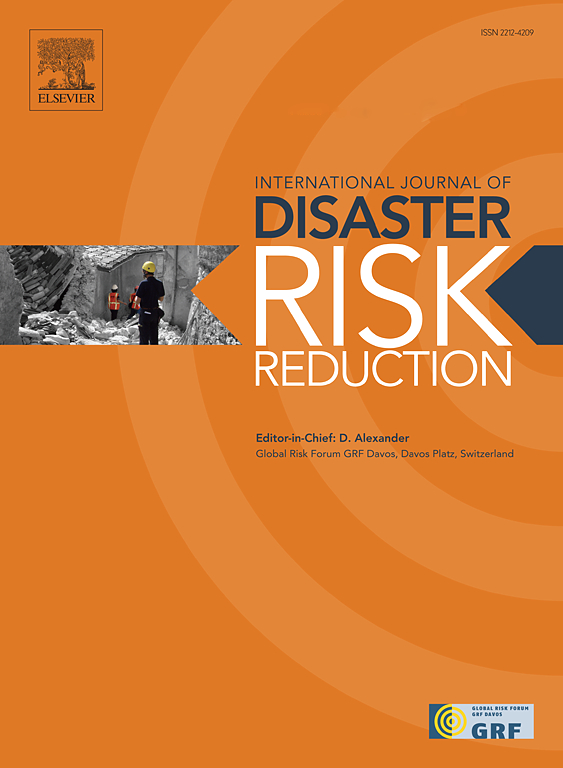Geospatial analysis of alarmingly increasing flood vulnerability and disaster risk within the northeast himalaya region of India
IF 4.2
1区 地球科学
Q1 GEOSCIENCES, MULTIDISCIPLINARY
International journal of disaster risk reduction
Pub Date : 2024-11-01
DOI:10.1016/j.ijdrr.2024.104920
引用次数: 0
Abstract
Geoenvironmetally the eastern part of the Himalaya region is highly vulnerable to flood and other natural disasters as it consists of fragmented and tectonically active geology and geomorphology, very high monsoon rainfall (>360 cm) and subsequent runoff, rugged hilly terrain with high ranges of elevation and slope, dense drainage density etc. Other hand, the unplanned developmental activities keep going and scaling up this vulnerability and risk to floods and other disasters. Addressing this burning issue, a geospatial technology-based case study of the Kohima district, Nagaland state (India), is presented here. The geospatial "technology-based" analyses employed in the study are thematic GIS mapping of flood hazard, vulnerability and risk controlling factors; and performing overlay operation using the AHP model in GIS software to generate spatio-temporal map layers of flood vulnerability and disaster risk. Results reveal that the region is under a high rate of monsoon climate change (increasing temperature, rainfall, rainy days, rainfall events and flood events with an annual rate of 0.35 %, 1.12 %, 0.36 %, 2.67 % and 4 % respectively), land use degradation (increasing built-up area with 0.60 %, annual rate decreasing forest, shrubs and water bodies with 0.80 % accumulated annual rates respectively) and demographic changes (increasing urban as well and rural population density with 0.53–2.10 % and 0.55–2.14 % respectively). Accumulated impacts of climate change, land use degradation and demographic changes causing an increase in flood hazard, vulnerability and disaster risk. Flood hazard zones and vulnerability zones extending with 0.50 % (4.89 km2) and 0.84 % (8.16 km2) annual rates respectively, subsequently the flood risk zones categorized as a moderate, high and very high potential risk, have been spreading out with a yearly rate of 0.07 % (0.65 km2), 0.13 % (1.31 km2) and 0.03 % (0.33 km2) respectively. It decreases the area under low and very low-risk zones by 0.17 % (1.63 km2) and 0.07 % (0.65 km2) annual rates respectively. Following up on these annual rates, the spatial distribution of flood hazard, vulnerability and risk zones for the next decade (2031–2040) have also been projected, revealing alarming situations, if flood disaster risk reduction (F-DRR) measures were not implemented in timely. It is strongly believed that the proposed study will be very useful for district-level planners and administrators to implement sustainable development planning, for the scientific fraternity to enhance their research work in the field of flood disaster management and for individuals for their safety in terms of life and property.
对印度东北部喜马拉雅地区惊人增长的洪水脆弱性和灾害风险的地理空间分析
从地质环境来看,喜马拉雅山脉东部地区非常容易遭受洪水和其他自然灾害,因为这里的地质和地貌破碎且构造活跃,季风降雨量(360 厘米)和随后的径流量非常大,丘陵地形崎岖不平,海拔和坡度范围大,排水系统密集等。另一方面,无计划的开发活动持续不断,加剧了洪水和其他灾害的脆弱性和风险。针对这一紧迫问题,本文介绍了一项基于地理空间技术的印度那加兰邦科希马县案例研究。研究中采用的地理空间 "基于技术 "的分析方法是:绘制洪水灾害、脆弱性和风险控制因素的专题地理信息系统地图;在地理信息系统软件中使用 AHP 模型进行叠加操作,生成洪水脆弱性和灾害风险的时空地图层。结果显示,该地区正处于季风气候变化(气温、降雨量、降雨日数、降雨事件和洪水事件分别以每年 0.35 %、1.12 %、0.36 %、2.67 % 和 4 % 的速度增加)、土地利用退化(建筑面积以每年 0.60 %,森林、灌木和水体年均减少率分别为 0.80 %)和人口变化(城市和农村人口密度分别增加 0.53-2.10 % 和 0.55-2.14 %)。气候变化、土地利用退化和人口变化的累积影响导致洪水危害、脆弱性和灾害风险增加。洪水危害区和洪水易发区分别以每年 0.50 %(4.89 平方公里)和 0.84 %(8.16 平方公里)的速度扩大,而被划分为中度、高度和极高度潜在风险的洪水风险区则以每年 0.07 %(0.65 平方公里)、0.13 %(1.31 平方公里)和 0.03 %(0.33 平方公里)的速度扩大。低风险区和极低风险区的面积每年分别减少 0.17 %(1.63 平方公里)和 0.07 %(0.65 平方公里)。根据这些年增长率,还预测了未来十年(2031-2040 年)洪水灾害、脆弱性和风险区的空间分布情况,如果不及时实施洪水灾害风险降低(F-DRR)措施,情况将令人担忧。我们坚信,拟议的研究将非常有助于地区一级的规划者和管理者实施可持续发展规划,有助于科学界加强在洪水灾害管理领域的研究工作,也有助于个人的生命和财产安全。
本文章由计算机程序翻译,如有差异,请以英文原文为准。
求助全文
约1分钟内获得全文
求助全文
来源期刊

International journal of disaster risk reduction
GEOSCIENCES, MULTIDISCIPLINARYMETEOROLOGY-METEOROLOGY & ATMOSPHERIC SCIENCES
CiteScore
8.70
自引率
18.00%
发文量
688
审稿时长
79 days
期刊介绍:
The International Journal of Disaster Risk Reduction (IJDRR) is the journal for researchers, policymakers and practitioners across diverse disciplines: earth sciences and their implications; environmental sciences; engineering; urban studies; geography; and the social sciences. IJDRR publishes fundamental and applied research, critical reviews, policy papers and case studies with a particular focus on multi-disciplinary research that aims to reduce the impact of natural, technological, social and intentional disasters. IJDRR stimulates exchange of ideas and knowledge transfer on disaster research, mitigation, adaptation, prevention and risk reduction at all geographical scales: local, national and international.
Key topics:-
-multifaceted disaster and cascading disasters
-the development of disaster risk reduction strategies and techniques
-discussion and development of effective warning and educational systems for risk management at all levels
-disasters associated with climate change
-vulnerability analysis and vulnerability trends
-emerging risks
-resilience against disasters.
The journal particularly encourages papers that approach risk from a multi-disciplinary perspective.
 求助内容:
求助内容: 应助结果提醒方式:
应助结果提醒方式:


